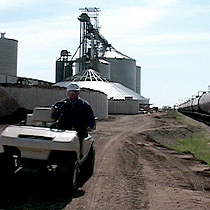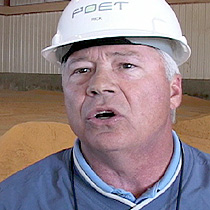2007年VOA标准英语-American Farmers Benefit from New Emphasis on E(在线收听)
Chancellor, South Dakota
21 June 2007
In an effort to lessen America's dependence on foreign oil imports and reduce pollution from vehicles burning gasoline, the U.S. government last year mandated that gasoline include a mixture of ten percent ethanol, and higher mixes are available in some areas for use by flex-fuel vehicles. Ethanol is grain alcohol derived from plants, and in the United States most of it comes from corn grown in Midwestern states. As VOA's Greg Flakus reports from Chancellor, South Dakota, increased demand for ethanol is driving an economical revival in the corn belt.
 |
| The Poet Energy Ethanol Plant in Chancellor, South Dakota |
"The ethanol plant uses it constantly, so there is always demand for the corn and it just keeps your prices more stable," he says.
Many of these plants began as local farm initiatives, so some people, like Lounsberry are also profiting from the investments they made many years ago.
"My father-in-law actually helped start the plant and we are real excited about this because it helps our economy and we get a little more for our grain that way,” explains Lounsberry. “And, if everything goes good, we get dividends, if the plant does good. So it has been a real plus for the farmers."
 |
| Poet Chancellor Plant manager Rick Serie |
What is left over is carbon dioxide and the fine gold powder is used as a feed for livestock, another important part of the local economy. In nearby Sioux Falls, the American Coalition for Ethanol keeps tabs on the industry and also lobbies for government support at both the state and federal level.
 |
| Brian Jennings, executive vice president |
Critics of ethanol complain that the fuel would not be cost effective for consumers if not for generous government subsidies, but Jennings says the support has helped create an industry that benefits the environment, consumers and rural economies.
"The ethanol industry has grown very rapidly in the last 24 months,” says Jennings. “We have virtually doubled in size over the last three or four years. Today, we have 125 ethanol plants in operation across 20 states. There are another 76 plants under construction in 23 states and we have the ability to make about six billion gallons of ethanol today."
Some studies have shown that it takes more energy to produce ethanol than it provides, but Jennings says the industry continues to advance technologically and that newer studies show a clear gain in energy from ethanol production.
"We are using less energy to make ethanol, we are yielding more ethanol per bushel of corn that goes through an ethanol plant, we are using less water to make ethanol than we did before. We are re-using and recycling more products in the process."
Although Jennings works for an organization that promotes ethanol, he concedes that neither ethanol nor any other single energy source will meet all of the country's fuel needs.
"We need other renewable fuels. We need biodiesel. We need things like butynal, and some of these other advanced bio-fuels that are being discussed today. We need conservation. This country finally needs to get a grip on the amount of energy that it uses."
Researchers are now working on ways of producing ethanol and other renewable fuels from trees, switchgrass and even the stalks left over in a field after corn is harvested.
Rick Serie says Poet Energy sees a need to develop such sources to meet growing demand. "We see that the corn supply is going to be maxed out at a certain point in the future for ethanol production, so what we are going to have to do is have other feed stock to produce ethanol."
Ethanol industry leaders say they are already working on plans to develop these so-called cellulosic biomass fuels, thereby providing farmers in America's heartland with a good market in the years to come.